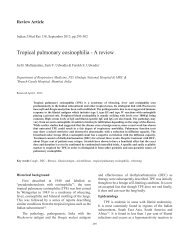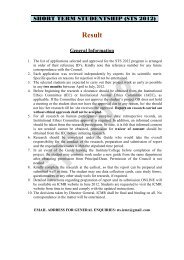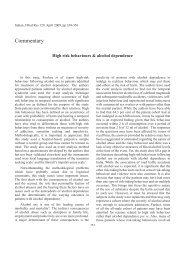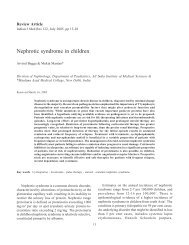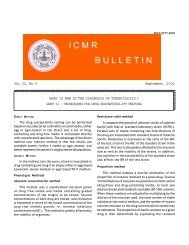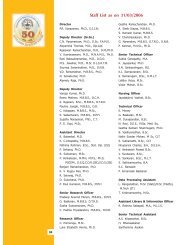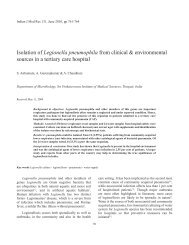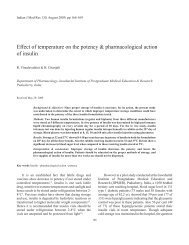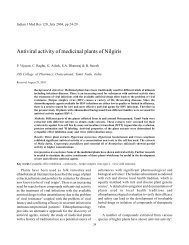Intestinal absorption of folic acid
Intestinal absorption of folic acid
Intestinal absorption of folic acid
Create successful ePaper yourself
Turn your PDF publications into a flip-book with our unique Google optimized e-Paper software.
Indian J Med Res 136, November 2012, pp 725-728<br />
Commentary<br />
<strong>Intestinal</strong> <strong>absorption</strong> <strong>of</strong> <strong>folic</strong> <strong>acid</strong> - new physiologic & molecular aspects<br />
Folate - vitamin B 9 - or its synthetic analogue <strong>folic</strong><br />
<strong>acid</strong> is essential for numerous metabolic functions such<br />
as biosynthesis <strong>of</strong> RNA and DNA, repair <strong>of</strong> DNA and<br />
methylation <strong>of</strong> DNA processes that are central in the<br />
maintenance <strong>of</strong> the integrity <strong>of</strong> the genome and the<br />
cells in the body. There is great interest in assessing<br />
the potential for changes in folate intake to modulate<br />
DNA methylation both as a biomarker for folate status<br />
and as a mechanistic link to developmental disorders<br />
and chronic diseases including cancer 1 . Folate also acts<br />
as a c<strong>of</strong>actor in many other vital biological processes,<br />
e.g. methylation <strong>of</strong> homocysteine and coupling with<br />
vitamin B 12 metabolism. It is especially important<br />
during periods <strong>of</strong> rapid cell division and growth, e.g.<br />
in pregnant women. Folate status and folate deficiency<br />
is most conveniently diagnosed by analysis <strong>of</strong> the<br />
plasma/serum folate concentration 2 , which is closely<br />
correlated to the erythrocyte folate concentration 3 .<br />
In the diet, folates exist as polyglutamates and<br />
need to be enzymatically converted into folate<br />
monoglutamates by folate reductase in the jejunal<br />
mucosa in order to be absorbed. In contrast, <strong>folic</strong><br />
<strong>acid</strong> is absorbed two-fold better than folates. Natural<br />
food folates are quite unstable compounds, so that<br />
losses in vitamin activity can be expected during food<br />
processing. In vegetables, up to 40 per cent <strong>of</strong> folates<br />
can be destroyed by cooking and in grains/cereals, up<br />
to 70 per cent <strong>of</strong> folates can be destroyed by milling<br />
and baking 2,4 .<br />
Folate/<strong>folic</strong> <strong>acid</strong> is not per se biologically<br />
active, but is converted into dihydr<strong>of</strong>olate (by the<br />
enzyme dihydr<strong>of</strong>olate synthetase) in the liver and<br />
into tetrahydr<strong>of</strong>olate by dihydr<strong>of</strong>olate reductase;<br />
this reaction is inhibited by the anti-metabolite<br />
methotrexate. Tetrahydr<strong>of</strong>olate is converted<br />
into 5,10-methylenetetrahydr<strong>of</strong>olate by serine<br />
725<br />
hydroxymethyltransferase 5 . Tetrahydr<strong>of</strong>olate as well as<br />
its methylated forms play a crucial role as methyl(ene)<br />
donors.<br />
“Absolute” folate deficiency is most frequently<br />
due to very low dietary folate intake but may also<br />
be caused by impaired folate <strong>absorption</strong> due to<br />
gastrointestinal diseases or genetic defects in the<br />
<strong>absorption</strong> mechanisms. “Functional” folate deficiency<br />
can be elicited by mutations causing impaired<br />
activity <strong>of</strong> folate processing enzymes. Severe folate<br />
deficiency has serious consequences and may cause<br />
megaloblastic, macrocytic anaemia, polyneuropathy,<br />
diarrhoea, cognitive impairment and behavioural<br />
disorders. Low levels <strong>of</strong> blood folate lead to increased<br />
plasma homocysteine, impaired DNA synthesis and<br />
DNA repair and may promote the development <strong>of</strong> some<br />
forms <strong>of</strong> cancers 6 .<br />
The preventive effect <strong>of</strong> a high <strong>folic</strong> <strong>acid</strong> intake<br />
against neural tube defects (NTD) is one <strong>of</strong> the most<br />
important nutritional discoveries 7 . Folate requirements<br />
are increased in life stages with amplified cell division<br />
such as pregnancy. It is assumed that on a population<br />
level, nutritional requirements for folate cannot be<br />
completely covered by a varied diet, as recommended<br />
by the National Health Authorities in the Nordic<br />
Countries 8 . Dietary intake is below recommendations in<br />
several Western societies, especially in populations <strong>of</strong><br />
low socio-economic status owing to low consumption<br />
<strong>of</strong> folate-rich foods, e.g. pulses, citrus fruits, and leafy<br />
vegetables. It is estimated that an additional intake <strong>of</strong><br />
50-180 μg folate would allow most people to reach the<br />
recommendations 9 .<br />
The most well-known consequences <strong>of</strong> folate<br />
deficiency are associated with pregnancy and may<br />
have serious impact on the foetus and newborn infant.<br />
Plasma folate and erythrocyte folate both decline during
726 INDIAN J MED RES, NOVEMBER 2012<br />
pregnancy and postpartum, probably due to increased<br />
folate demands combined with an inadequate folate<br />
intake 3 . From 18 wk gestation to 8 wk postpartum, the<br />
frequency <strong>of</strong> low plasma folate
The long absorptive pathway could be a consequence<br />
<strong>of</strong> the very important function <strong>of</strong> folate in maintaining<br />
genetic body homeostasis.<br />
After Roux-en-Y gastric bypass, many patients<br />
develop folate deficiency. This highlights the<br />
importance <strong>of</strong> the high absorptive capacity for folate in<br />
the <strong>acid</strong>ic milieu in duodenum and proximal jejunum,<br />
which is eliminated by the operation 22 . However, a<br />
daily supplement <strong>of</strong> 400 µg <strong>folic</strong> <strong>acid</strong> is sufficient to<br />
alleviate deficiency, because the absorptive capacity in<br />
the remaining part <strong>of</strong> the intestines is able to compensate<br />
for the lost <strong>absorption</strong> in the proximal part <strong>of</strong> the small<br />
intestine.<br />
Folate deficient rats did not thrive compared to<br />
their folate replete mates 17 . Severe, long-standing folate<br />
deficiency may cause gastrointestinal problems and in<br />
theory this might impair the production <strong>of</strong> mRNA and<br />
DNA necessary for synthesis <strong>of</strong> RFC and PCFT and<br />
introduce a vicious circle <strong>of</strong> folate mal<strong>absorption</strong>. Wani<br />
et al 17 studied the aspects <strong>of</strong> intestinal folate uptake<br />
in folate replete and folate deficient rats using the<br />
technique <strong>of</strong> intestinal brush border membrane vesicles<br />
(BBMV) from isolated small intestinal epithelial cells.<br />
They showed that folate deficiency for a (short) period<br />
<strong>of</strong> 90 days in rats caused a physiological and beneficial<br />
upregulation <strong>of</strong> the absorptive mechanisms in the<br />
proximal 2/3 rd <strong>of</strong> the small intestine 17 . The uptake <strong>of</strong><br />
<strong>folic</strong> <strong>acid</strong> was pH dependent with a maximum at <strong>acid</strong>ic<br />
pH <strong>of</strong> 5.5. It followed the enzyme kinetics <strong>of</strong> Michaelis-<br />
Menten consistant with a carrier-mediated transport.<br />
Further, the uptake was dependent on temperature<br />
showing a decrease at temperatures below 37°C.<br />
Young enterocytes are made by division <strong>of</strong><br />
enterocyte “stem” cells at the crypt base and mature<br />
gradually as they move towards the villus tip where<br />
they die and are exfoliated. The results <strong>of</strong> Wani et al 17<br />
showed that <strong>folic</strong> <strong>acid</strong> uptake increased with increasing<br />
maturity <strong>of</strong> the enterocytes and was highest in the cells<br />
located at the tip <strong>of</strong> the villus. This finding was further<br />
substantiated by significantly higher levels <strong>of</strong> mRNA<br />
for RFC and PCFT in BBMV from folate deficient rats<br />
compared to folate replete rats and increasing expression<br />
<strong>of</strong> mRNA for RFC and PCFT in enterocytes along<br />
the crypt-villus axis. The increase in specific mRNA<br />
resulted in an increased expression <strong>of</strong> both the RFC and<br />
PCFT proteins as confirmed by Western blot analysis.<br />
Furthermore, using labelled S-adenosylmethionine,<br />
there was evidence <strong>of</strong> a decreased methylation rate <strong>of</strong><br />
DNA in folate deficient rats in comparison with their<br />
folate replete mates.<br />
MILMAN: INTESTINAL ABSORPTION OF FOLIC ACID 727<br />
In conclusion, this thorough, detailed and<br />
exhaustive scientific evidence presented by Wani &<br />
colleagues 17 has to a great extent contributed to increase<br />
our knowledge and understanding <strong>of</strong> the complexity <strong>of</strong><br />
the intestinal <strong>absorption</strong> <strong>of</strong> <strong>folic</strong> <strong>acid</strong>. Hopefully, their<br />
findings can be interpreted and employed to elaborate<br />
a better prevention and combat against the global<br />
problem <strong>of</strong> human folate deficiency.<br />
Nils Milman<br />
Department <strong>of</strong> Clinical Biochemistry<br />
Naestved Hospital<br />
DK-4700 Naestved<br />
Denmark<br />
nils.mil@dadlnet.dk<br />
References<br />
1. Crider KS,<br />
Yang TP, Berry RJ, Bailey LB. Folate and DNA<br />
methylation: a review <strong>of</strong> molecular mechanisms and the<br />
evidence for folate’s role. Adv Nutr 2012; 3 : 21-38.<br />
2.<br />
3.<br />
Benoist B. Conclusions <strong>of</strong> a WHO Technical consultation on<br />
folate and vitamin B12 deficiencies. Food Nutr Bull 2008; 29<br />
(Suppl): S238-44.<br />
Milman N, Byg K-E, Hvas A-M, Bergholt T, Eriksen L.<br />
Erythrocyte folate, plasma folate and plasma homocysteine<br />
during normal pregnancy and postpartum: a longitudinal<br />
study comprising 404 Danish women. Eur J Haematol 2006:<br />
76 : 200-5.<br />
4. Caudill MA. Folate bioavailability: implications for<br />
establishing dietary recommendations and optimizing status.<br />
Am J Clin Nutr 2010; 91 : 1455S-60S.<br />
5.<br />
6.<br />
7.<br />
8.<br />
9.<br />
Balion C, Kapur BM. Folate. Clinical utility <strong>of</strong> serum and red<br />
blood cell analysis. Clin Lab News 2011; 37 : 8-9.<br />
Weinstein SJ, Hartman TJ, Stolzenberg-Solomon R, Pietinen<br />
P, Barrett MJ, Taylor PR, et al. Null Association between<br />
prostate cancer and serum folate, vitamin B6, vitamin B12,<br />
and homocysteine. Cancer Epidemiol Biomarkers Prev 2003;<br />
12 : 1271-2.<br />
Katan MB, Boekschoten MV, Connor WE, Mensink RP,<br />
Seidell J, Vessby B, et al. Which are the greatest recent<br />
discoveries and the greatest future challenges in nutrition? Eur<br />
J Clin Nutr 2009; 63 : 2-10.<br />
Nordic Nutrition Recommendations NNR 2004 Integrating<br />
Nutrition and Physical Activity. Stockholm, Sweden: Nordic<br />
Council <strong>of</strong> Ministers; 2005.<br />
de Bree A, van Dusseldorp M, Brouwer IA, van het H<strong>of</strong> KH,<br />
Steegers-Theunissen RPM. Review folate intake in Europe:<br />
recommended, actual and desired intake. Eur J Clin Nutr<br />
1997; 51 : 643-60.<br />
10. National Food Agency <strong>of</strong> Denmark ( Levnedsmiddelstyrelsen).<br />
Folate and neural tube defects (folat og neuralrørsdefekter)<br />
Publication no.285. Copenhagen: National Food Agency <strong>of</strong><br />
Denmark; 1997.<br />
11. National Food Agency <strong>of</strong> Denmark ( Fødevaredirektoratet).<br />
Folate and neural tube defects (folat og neuralrørsdefekter)
728 INDIAN J MED RES, NOVEMBER 2012<br />
Publication no.2003:01. Copenhagen: National Food Agency<br />
<strong>of</strong> Denmark; 2003.<br />
12. Mitchell LE, Adzick NS, Melchionne J, Pasquariello PS,<br />
Sutton LN, Whitehead AS. Spina bifida. Lancet 2004; 364 :<br />
1885-95.<br />
13. http://www.sph.emory.edu/wheatflour/,<br />
accessed on May 14,<br />
2012.<br />
14. Mosley BS, Cleves MA, Siega-Riz AM, Shaw GM, Canfield<br />
MA, Waller DK, et al. Neural tube defects and maternal<br />
folate intake among pregnancies conceived after <strong>folic</strong> <strong>acid</strong><br />
fortification in the United States. Am J Epidemiol 2009; 169<br />
: 9-17.<br />
15. Nordic Council <strong>of</strong> Ministers. The Nordic nutrition<br />
recommendations, 4th ed. Copenhagen: Norden; 2004.<br />
p. 287-96.<br />
16. Kelly D, O‘Dowd T, Reulbach U. Use <strong>of</strong> <strong>folic</strong> <strong>acid</strong> supplements<br />
and risk <strong>of</strong> cleft lip and palate in infants: a population-based<br />
cohort study. Br J Gen Pract 2012; 62 : 466-72.<br />
17. Wani NA, Thakur S, Kaur J. Mechanism <strong>of</strong> intestinal folate<br />
transport during folate deficiency in rodent model. Indian J<br />
Med Res 2012; 136 : 758-65.<br />
18. Dudeja PK,<br />
Torania SA, Said HM. Evidence for the existence<br />
<strong>of</strong> a carrier-mediated folate uptake mechanism in human<br />
colonic luminal membranes. Am J Physiol 1997; 272 : G1408-<br />
15.<br />
19. Dudeja PK,<br />
Kode A, Alnounou M, Tyagi S, Torania S,<br />
Subramanian VS, et al. Mechanism <strong>of</strong> folate transport across<br />
the human colonic basolateral membrane. Am J Physiol<br />
Gastrointest Liver Physiol 2001; 281 : G54-60.<br />
20. Qiu A, Jansen M, Sakaris A, Min SH, Chattopadhyay S, Tsai<br />
E, et al. Identification <strong>of</strong> an intestinal folate transporter and<br />
the molecular basis for hereditary folate mal<strong>absorption</strong>. Cell<br />
2006; 127 : 917-28.<br />
21. Gonen N, Assaraf YG. The obligatory intestinal folate<br />
transporter PCFT (SLC46A1) is regulated by nuclear<br />
respiratory factor 1 (NRF-1). J Biol Chem 2010; 285 : 33602-<br />
13.<br />
22. Aarts EO,<br />
van Wageningen B, Janssen IM, Berends FJ.<br />
Prevalence <strong>of</strong> anemia and related deficiencies in the first year<br />
following laparoscopic gastric bypass for morbid obesity.<br />
J Obes 2012 : 193705 E pub 2012, Mar13.



